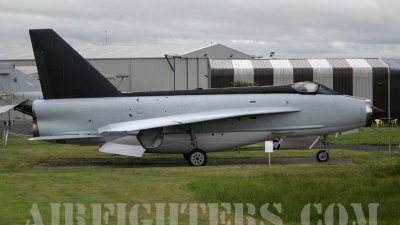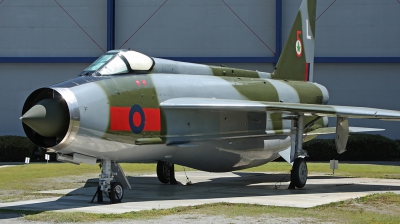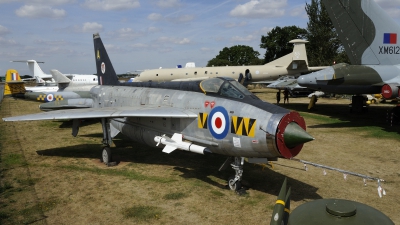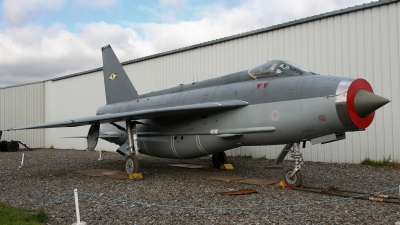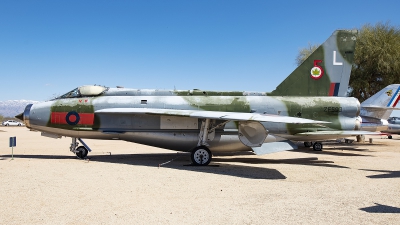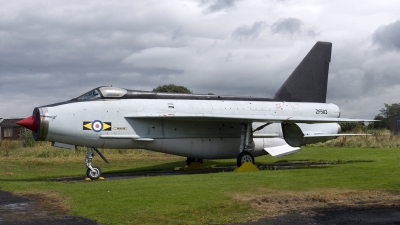English Electric Lightning F53 Aircraft Data
The Lightning F.53, otherwise known as the Export Lightning, developed as a private venture by BAC. While the Lightning had originated as an interception aircraft, this version was to have a multirole capability for quickly interchanging between interception, reconnaissance, and ground-attack duties. The F.53 was based on the F.6 airframe and avionics, including the large ventral fuel tank, cambered wing and overwing pylons for drop tanks of the F.6, but incorporated an additional pair of hardpoints under the outer wing. A gun pack carrying two ADEN cannons and 120 rounds each could replace the forward part of the ventral fuel tank. Alternative, interchangeable packs in the forward fuselage carried two Firestreak missiles, two Red Top missiles, twin retractable launchers for 44 2-inch (50mm) air-to-air rockets, or a reconnaissance pod fitted with five 70 mm Type 360 Vinten cameras. The Lightning F.53 was equipped with the A.I.23S radar, the export version of the A.I.23B as fitted in the F.6.
Lightning for Saudi Arabia
Towards the end of 1965 the RSAF officially announced that it would place an order for 40 Lightning aircraft as part of a larger defence sales deal between the United Kingdom and Saudi Arabia. The Lightning part of the huge Al Yamamah defence contract specified an order for 34 fighter aircraft, designated Lightning F.53 and six dual-seat trainers, Lightning T.55. As an interim measure to expedite the introduction of the Lightning into the RSAF, the RAF released four F.2s from storage as well as two T.4 trainers which had recently been replaced in RAF service by the Lightning T.5. The Saudi Support Unit was set up at Warton to train RSAF-personnel, whilst aircrew were detached to the RAF's Lightning Conversion Unit at Coltishall. At the time when a sufficient number of Saudi students had qualified as instructors, the Saudi Lightning Conversion Unit (LCU) was set up at King Abdulaziz Air Base, Dhahran.
Three operational RSAF units transferred to the Lightning: No.6 Squadron at Riyadh Air Base was the first to be established, with No.2 Squadron at Dhahran (and later transferred to King Faisal Air Base, Tabuk) to follow in the autumn of 1969. It was not until 1978 that the third RSAF unit was formed on Lightnings. No.13 Squadron at Dhahran also provided training for RSAF pilots after the LCU had disbanded.
Kuwait Air Force Lightning
The third operator of the Lightning, after the United Kingdom and Saudi Arabia, was the Kuwait Air Force. Kuwait had bought twelve Lightning F.53s, designated F.53K, and two T.55 trainers or T.55K in Kuwaiti service. The aircraft were delivered between December 1968 and December 1969. The Lightnings were initially based at Kuwait City International Airport, but with mounting traffic at the airport, the aircraft were also flown from other airfields, such as Ali Al Salem Air Base. As these airfields were generally less well equipped for Lightning operations, the Air Force struggled with the serviceablity of the demanding Lightning. By 1977 the Dassault Mirage F1 had replaced the iconic Lightning in Kuwait Air Force service.
The F.53 prototype
Lightning F.3 XR722 first flew on 23 January 1965 but was subsequently placed in storage at Warton awaiting conversion to F.6. The machine was selected to become the F.53 protype and was modified as such. The first flight of the prototype (registered G27-2, and with Royal Saudi Air Force serial 53-666) was conducted from Warton on 19 October 1966. On 28 August 1969 53-666 was flown to Saudi Arabia (registered G27-37-1G) for delivery to No.1 Squadron, RSAF. This Lightning crashed at Khamis Mushayt on 6 February 1972.
Lightning F.53 production, serials and construction numbers
The Lightning production for Saudi Arabia and Kuwait commenced with the first batch of aircraft for the RSAF. These were 53-667 (c/n 95272) to 53-686 (c/n 95291). The following aircraft on the production line, c/n 95292, was the first F.53K for the Kuwait Air Force, serial 53-412.
The next six aircraft (c/n 95293 to 95298) went to the RSAF, with serials 53-687 to 53-692. F.53 with c/n 95299 became 53-413 with the Kuwait Air Force, to be followed by seven Saudi aircraft: c/n 95300 to 95306 became 53-693 to 53306. The very last RSAF was c/n 95317 (serial 53-700) which was completed after the final Kuwaiti aircraft. These were c/n 95307 to 95316. These Lightnings entered service with serials 53-414 to 53-423.
RSAF serials:
53-666 to 53-700.
KAF serials:
53-412 to 53-423.
With the introduction of the F-15 Eagle in RSAF-service, the remaining Lighting F-53s en T.55s were withdrawn from use. British Aerospace purchased the aircraft back for refurbishment and re-sale. Prior the delivery flight all RSAF markings were removed and replaced by British markings and serials (ZF577 to ZF598). A total of 18 F.53s and four T.55 were flown back to the UK by RAF Lightning pilots from Binbrook in January 1986, with 13 aircraft returning at Warton on 14 January: 53-668 (ZF577); 53-670 (ZF578); 53-671 (ZF579); 53-672 (ZF580); 53-675 (ZF581); 53-681 (ZF583); 53-683 (ZF585); 53-693 (ZF588); 53-700 (ZF589); 53-685 (ZF591); 53-696 (ZF594), all F.53's and two T.55s: 55-711 (ZF597) and 55-713 (ZF598). The last flight of nine Lightnings followed on 22 January: 53-676 (ZF582); 53-682 (ZF584); 53-688 (ZF586); 53-691 (ZF587); 53-679 (ZF590); 53-686 (ZF592); 53-692 (ZF593) all F.53s and the last two T.55s: 55-714 (ZF595) and 55-715 (ZF596).
A re-sale never materialised and the Lightnings eventually found their way to private collectors and museums in the British Isles and overseas, most as complete aircraft, of other Lightnings, only the forward fuselage/cockpit section was preserved.
Lightning for Saudi Arabia
Towards the end of 1965 the RSAF officially announced that it would place an order for 40 Lightning aircraft as part of a larger defence sales deal between the United Kingdom and Saudi Arabia. The Lightning part of the huge Al Yamamah defence contract specified an order for 34 fighter aircraft, designated Lightning F.53 and six dual-seat trainers, Lightning T.55. As an interim measure to expedite the introduction of the Lightning into the RSAF, the RAF released four F.2s from storage as well as two T.4 trainers which had recently been replaced in RAF service by the Lightning T.5. The Saudi Support Unit was set up at Warton to train RSAF-personnel, whilst aircrew were detached to the RAF's Lightning Conversion Unit at Coltishall. At the time when a sufficient number of Saudi students had qualified as instructors, the Saudi Lightning Conversion Unit (LCU) was set up at King Abdulaziz Air Base, Dhahran.
Three operational RSAF units transferred to the Lightning: No.6 Squadron at Riyadh Air Base was the first to be established, with No.2 Squadron at Dhahran (and later transferred to King Faisal Air Base, Tabuk) to follow in the autumn of 1969. It was not until 1978 that the third RSAF unit was formed on Lightnings. No.13 Squadron at Dhahran also provided training for RSAF pilots after the LCU had disbanded.
Kuwait Air Force Lightning
The third operator of the Lightning, after the United Kingdom and Saudi Arabia, was the Kuwait Air Force. Kuwait had bought twelve Lightning F.53s, designated F.53K, and two T.55 trainers or T.55K in Kuwaiti service. The aircraft were delivered between December 1968 and December 1969. The Lightnings were initially based at Kuwait City International Airport, but with mounting traffic at the airport, the aircraft were also flown from other airfields, such as Ali Al Salem Air Base. As these airfields were generally less well equipped for Lightning operations, the Air Force struggled with the serviceablity of the demanding Lightning. By 1977 the Dassault Mirage F1 had replaced the iconic Lightning in Kuwait Air Force service.
The F.53 prototype
Lightning F.3 XR722 first flew on 23 January 1965 but was subsequently placed in storage at Warton awaiting conversion to F.6. The machine was selected to become the F.53 protype and was modified as such. The first flight of the prototype (registered G27-2, and with Royal Saudi Air Force serial 53-666) was conducted from Warton on 19 October 1966. On 28 August 1969 53-666 was flown to Saudi Arabia (registered G27-37-1G) for delivery to No.1 Squadron, RSAF. This Lightning crashed at Khamis Mushayt on 6 February 1972.
Lightning F.53 production, serials and construction numbers
The Lightning production for Saudi Arabia and Kuwait commenced with the first batch of aircraft for the RSAF. These were 53-667 (c/n 95272) to 53-686 (c/n 95291). The following aircraft on the production line, c/n 95292, was the first F.53K for the Kuwait Air Force, serial 53-412.
The next six aircraft (c/n 95293 to 95298) went to the RSAF, with serials 53-687 to 53-692. F.53 with c/n 95299 became 53-413 with the Kuwait Air Force, to be followed by seven Saudi aircraft: c/n 95300 to 95306 became 53-693 to 53306. The very last RSAF was c/n 95317 (serial 53-700) which was completed after the final Kuwaiti aircraft. These were c/n 95307 to 95316. These Lightnings entered service with serials 53-414 to 53-423.
RSAF serials:
53-666 to 53-700.
KAF serials:
53-412 to 53-423.
With the introduction of the F-15 Eagle in RSAF-service, the remaining Lighting F-53s en T.55s were withdrawn from use. British Aerospace purchased the aircraft back for refurbishment and re-sale. Prior the delivery flight all RSAF markings were removed and replaced by British markings and serials (ZF577 to ZF598). A total of 18 F.53s and four T.55 were flown back to the UK by RAF Lightning pilots from Binbrook in January 1986, with 13 aircraft returning at Warton on 14 January: 53-668 (ZF577); 53-670 (ZF578); 53-671 (ZF579); 53-672 (ZF580); 53-675 (ZF581); 53-681 (ZF583); 53-683 (ZF585); 53-693 (ZF588); 53-700 (ZF589); 53-685 (ZF591); 53-696 (ZF594), all F.53's and two T.55s: 55-711 (ZF597) and 55-713 (ZF598). The last flight of nine Lightnings followed on 22 January: 53-676 (ZF582); 53-682 (ZF584); 53-688 (ZF586); 53-691 (ZF587); 53-679 (ZF590); 53-686 (ZF592); 53-692 (ZF593) all F.53s and the last two T.55s: 55-714 (ZF595) and 55-715 (ZF596).
A re-sale never materialised and the Lightnings eventually found their way to private collectors and museums in the British Isles and overseas, most as complete aircraft, of other Lightnings, only the forward fuselage/cockpit section was preserved.
- Country of Origin: United Kingdom
- First Flight: 19 October 1966
- Initial Service Date:
- No. Built: 46
- No. In Service: 0
- No. of Hardpoints: 6
- Crew: 1
Power:
2 Rolls Royce RA.24R Avon Mk.302C at 12,690 lbf
Weapons:
Of all Lightning versions, the F.53 was capable to carry a most diverse and impressive weapons load, in several configurations.
The forward section of the F.53's ventral pack was designed so that it could be interchanged with a self-contained pack comprising two Aden cannon with up to 120 rounds of 30mm ammunition per gun, while the lower weapons pack could accommodate either two guided missiles (Red Top or Firestreak) or 44 2-inch (50mm) rockets, capable of being fired in ripples. As on the RAF's F.6, the wings had been strengthened to take two 260 Imperial gallon overwing fuel tanks. These could be replaced by a 1,000 lb bomb on each overwing pylon. The pylon could be used to carry a Matra 155 pod containing 18 2.68-inch (68mm) SNEB unguided air-to-ground projectiles. An alternative load could be one Matra 100 SNEB rocket pod with a 50 Imperial gallon fuel tank per overwing pylon.
At the 1969 Salon Aeronautique in Paris, the British Aircraft Corporation had Lightning F.53K serial 53-418 (destined for the Kuwait Air Force) on display fitted with an impressive (dummy) ordnace load. Of paricular interest was the combination of a SNEB rocket launcher forming the forward section of a 227 litre fuel tank. Special vents between the rear of the SNEB pod and the fuel tank allowed exhaust gases to discharge when the rockets were fired. Per overwing pylon two of these combinations could be carried.
Under the outboard section of the wing another hardpoint, capable of stores up to 2,000 lbs in weight, could accommodate two Matra 155 rocket pods or two 1,000 lbs bombs. In combination with the fuselage mounted armament, the weight per underwing store was limited to 1,000 lbs.
In place of the fuselage weaponry, a reconnaissance suite containing five Vinten cameras, allowing vertical, oblique and forward photography for both day and night use.
The forward section of the F.53's ventral pack was designed so that it could be interchanged with a self-contained pack comprising two Aden cannon with up to 120 rounds of 30mm ammunition per gun, while the lower weapons pack could accommodate either two guided missiles (Red Top or Firestreak) or 44 2-inch (50mm) rockets, capable of being fired in ripples. As on the RAF's F.6, the wings had been strengthened to take two 260 Imperial gallon overwing fuel tanks. These could be replaced by a 1,000 lb bomb on each overwing pylon. The pylon could be used to carry a Matra 155 pod containing 18 2.68-inch (68mm) SNEB unguided air-to-ground projectiles. An alternative load could be one Matra 100 SNEB rocket pod with a 50 Imperial gallon fuel tank per overwing pylon.
At the 1969 Salon Aeronautique in Paris, the British Aircraft Corporation had Lightning F.53K serial 53-418 (destined for the Kuwait Air Force) on display fitted with an impressive (dummy) ordnace load. Of paricular interest was the combination of a SNEB rocket launcher forming the forward section of a 227 litre fuel tank. Special vents between the rear of the SNEB pod and the fuel tank allowed exhaust gases to discharge when the rockets were fired. Per overwing pylon two of these combinations could be carried.
Under the outboard section of the wing another hardpoint, capable of stores up to 2,000 lbs in weight, could accommodate two Matra 155 rocket pods or two 1,000 lbs bombs. In combination with the fuselage mounted armament, the weight per underwing store was limited to 1,000 lbs.
In place of the fuselage weaponry, a reconnaissance suite containing five Vinten cameras, allowing vertical, oblique and forward photography for both day and night use.
Dimensions:
| Length: | 55 ft 3 in. |
| Wing Span: | 34 ft 10 in. |
| Wing Area: | 474,5 sq.ft |
| Height: | 19 ft 7 in. |
| Empty Weight: | 28,041 lbs |
| Max. Weight: | 41,700 lbs |
Performance:
| Service Ceiling: | 65,000+ ft. |
Operators:
KuwaitSaudi Arabia
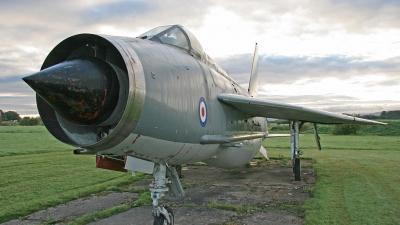
 Random great photos of the English Electric Lightning F53:
Random great photos of the English Electric Lightning F53:
